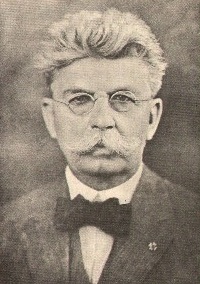Francis "Borax" Smith
Click here for Bay Area History category page |
Francis Marion Smith (aka "Borax" Smith and the "Borax King") (b.February 2, 1846 †August 27, 1931) was an American business magnate and civic builder of Oakland, California.
Smith Mountain in Death Valley is named after him.
Smith was born in Richmond, Walworth County, Wisconsin in 1846. At the age of 21, he left Wisconsin to prospect for mineral wealth in the American Old West.
In 1872, while working as a woodcutter, he discovered a rich supply of ulexite at Teel's Marsh in Nevada. He staked a claim, started a company with his brother Julius, and established a borax works at the edge of the marsh to convert ulexite into borax. In 1877, Scientific American reported that the Smith Brothers shipped their product in a 30-ton load using two large wagons with a third wagon for food and water drawn by a 24-mule team over a 160-mile stretch of desert between Teel's Marsh and Wadsworth, Nevada, some six years before similar twenty mule teams were introduced into Death Valley, California.
- Side note
- Twenty-Mule-Team Borax is named after the twenty mule teams that were used by William Tell Coleman's company to move borax out of Death Valley, California to the nearest rail spur between 1883 and 1889. Francis "Borax" Smith acquired Coleman's holdings in 1890 and consolidated them with his own to form the Pacific Coast Borax Company. After the mule teams had already been replaced by a new rail spur, the name 20 Mule Team Borax was established and aggressively promoted by Pacific Coast Borax as a way to increase sales of its product. Stephen Mather, son of J.W. Mather, the administrator of the company's New York office, persuaded Smith to add the name 20 Mule Team Borax to go with the famous sketch of the mule team already on the box. The twenty mule team symbol was first used in 1891 and registered in 1894. In 1988, just over 20 years after the acquisition of U.S. Borax by Rio Tinto Group, the Boraxo, Borateem, and 20-Mule Team product lines were sold to Dial Corporation by U.S. Borax.
- In 1884, Smith bought out his brother. He then gained control of all major borax production in western Nevada. In 1890, he acquired William Tell Coleman's borax holdings in Death Valley and consolidated them with his own to form the Pacific Coast Borax Company. Smith's company then established and aggressively promoted the Twenty-Mule-Team Borax trademark, which was named after the twenty mule teams that had been used to transport borax out of Death Valley by Coleman's company. He also formed the Tonopah & Tidewater Railroad to ship his borax.
Smith married and settled in Oakland, California in 1881 where he had an estate constructed across the street from what is today the site of Oakland High School. In nearby Alameda, he built America’s first reinforced concrete building for his Pacific Coast Borax Company's refinery. He also created the Key System, a commuter train, ferry and streetcar system serving the East Bay, with a significant sideline in real estate. He also built Idora Park in Oakland to attract riders to the trolleys on weekends.
With his fortune, Smith also purchased an estate on Shelter Island in New York. shelter-island.org
Francis Marion Smith died in Oakland in 1931 at the age of 85. He is buried in the city's Mountain View Cemetery (in Oakland, California) along "Millionaires Row".
The Western Railway Museum's library is named for "Borax" Smith.
A public park in Oakland is also named for him. It occupies a portion of his former estate.
"Borax" Smith is a character in the historical fiction novel Carter Beats the Devil by Glen David Gold < ISBN:0-7868-8632-3 >
References
- Hildebrand, GH. (1982) Borax Pioneer: Francis Marion Smith. San Diego: Howell-North Books. < ISBN:0-8310-7148-6 >
- Smith, Francis Marion. (Unpublished) circa 1925. Autobiographical Notes on His Early Life.
External links
Chat rooms • What links here • Copyright info • Contact information • Category:Root
